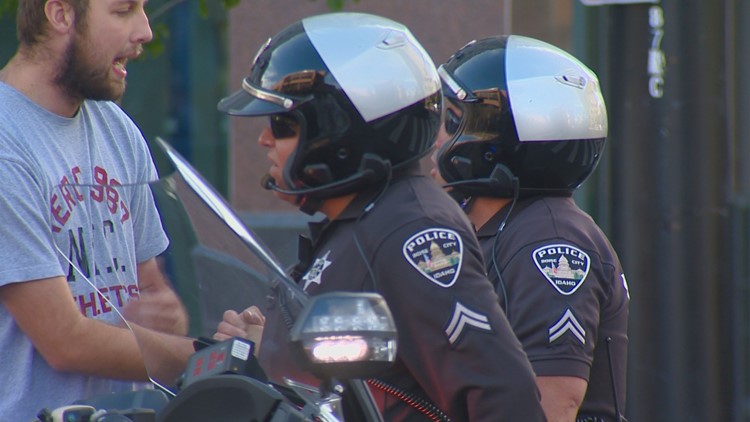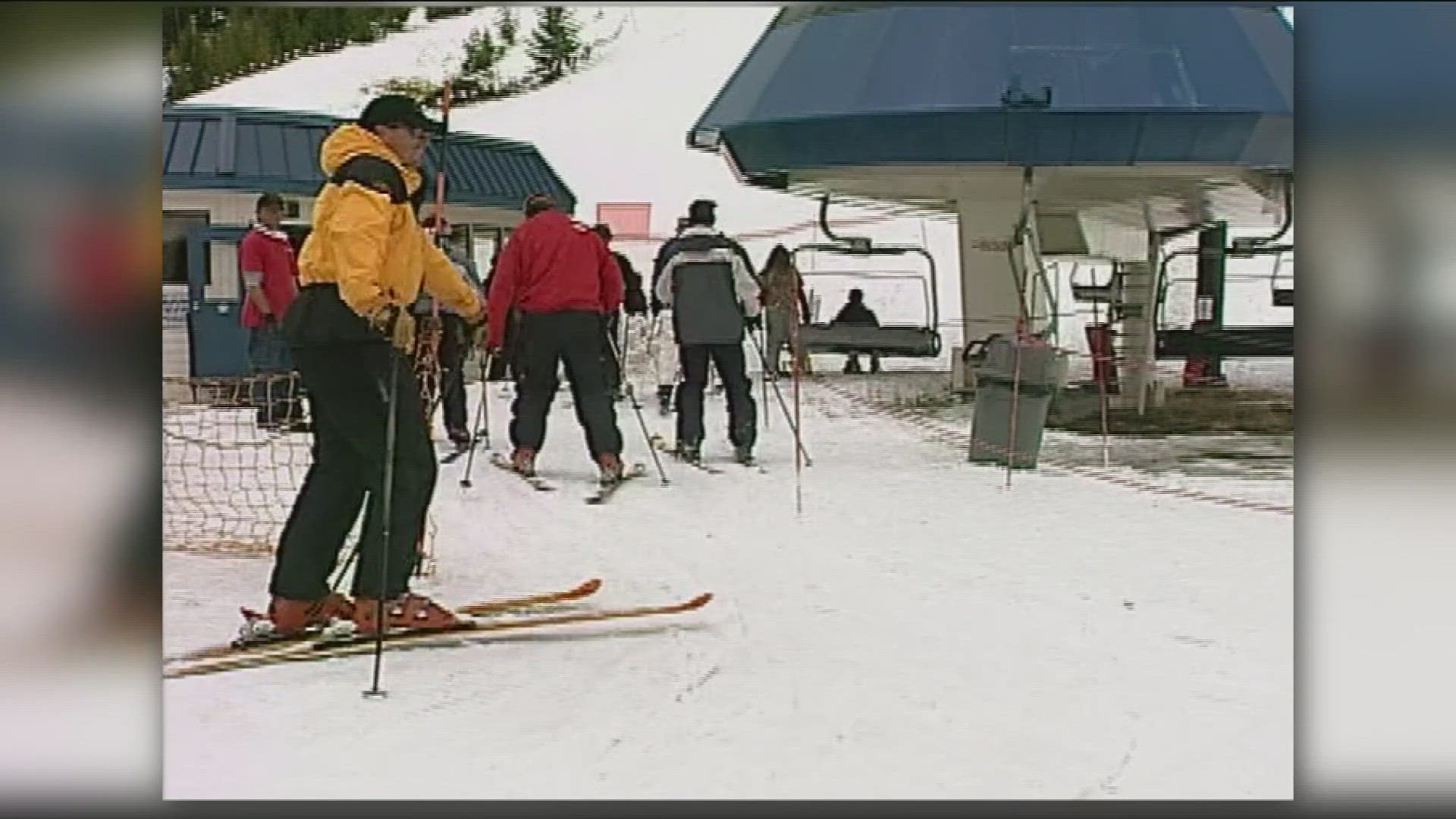BOISE, Idaho — Editor's Note: This article was originally published by The Idaho Press.
As Boise grows in population, the city’s police force is having to adapt to a larger city, new types of crime, and a national downward trend in police recruitment as it attempts to expand the force and place further emphasis on community policing.
Boise Police Chief Ryan Lee told city council last month the police department will potentially need to hire an additional 100 officers over the next decade in response to population growth.
According to estimates from the Community Planning Association of Southwest Idaho and the U.S. Census Bureau, the city’s population grew by 31,000 between 2010 and 2020.
The Boise Police Department has a force of about 400 sworn officers and civilian employees, according to its 2020 annual report. Roughly 300 of the total staff are police officers.
Lee framed the police department’s functionality as a health care system that should be focused on prevention first, then emergency services. It should also provide specialists, community partnerships, research and training and customer service, and improve the quality of life in the city.
Standing in the way of that expansion are a number of factors including skyrocketing home prices, a lack of affordable housing, and competition with other service-oriented professions to source the best candidates, Lee said.
DOWNWARD TREND
The Boise Police Department’s push to expand comes at a time when police recruitment is trending downward nationally. According to a 2019 report by the Police Executive Research Forum, fewer people are applying to become police officers and more people are leaving the profession after only a few years on the job.
The current downward trend in police recruiting is a long-term trend across the country, according to the report, and is compounded by the fact that large numbers of personnel are eligible to retire in the next several years.
FBI Uniform Crime Reporting date from 2018, shows the national average for sworn officers per 1,000 residents is 2.4. In Boise, the average is 1.24, which is less than the 1.3 per thousand rate the city had in 2014.
A 2014 police staffing report from the Madison, Wisconsin, Police Department showed that Boise had the fewest officers per 1,000 residents of any of the cities in its list of comparable peer cities, which included Des Moines, Iowa; Baton Rouge, Louisiana; Greensboro, North Carolina; and St. Paul, Minnesota. The next lowest ratio in the report was Des Moines with 1.8 officers per 1,000 residents.
Asked whether the national political conversation around policing affects the ability to recruit, Lee told the city council on April 20, “We’re seeing lateral officers from other communities making the decision to come here to Boise for all of the right reasons. … However, when we look at (officers) new to the profession of policing, the national narrative has had an impact on that.”
Lee recalled 4,000 people showing up at the Oregon Convention Center the day he took the test to become an officer with the Portland Police Bureau just over two decades ago. But when the Boise Police Department recently posted new positions, “we had 89 people sign up. Thirty-eight people actually bothered to take the test. We’ll be lucky if that yields us two officers,” he said.
Boise PD is working to address this both internally and externally, by evaluating department policies that might exclude qualified candidates while also attempting to ensure that all demographics are represented on its force.
The city of Boise currently lists the department’s demographic breakdown as 91% white, 3% Black/African American, 1% Asian, 4% Hispanic/Latino, and 1% Native Hawaiian/Pacific Islander.
This is compared with the city’s demographics documented at 89.1% white, 2.1% Black/African-American, 0.6% American Indian or Alaska Native, 3.1% Asian, 0.2% Native Hawaiian/Pacific Islander, 9% Hispanic/Latino, and 3.3% two or more races.
HOUSING PRICES
“It has become a real challenge to bring people aboard here,” said Lee, referencing recent reporting by KTVB stating that home prices have soared 73% in Idaho across the last five years while wages have remained stagnant, growing just 14% in that same time period, according to the Idaho Department of Labor.
Boise police officers make between $49,254 and $67,970 per year. In other large Intermountain West cities, salaries can be nearly equivalent or higher. In Salt Lake City, Utah, officers make between $40,321 and $70,771 per year. In Spokane, Washington, officers start at $55,270, can make $80,513 after five years, and can earn a maximum of $88,406 after 30 years of service.
Rents in Boise rose by 12.4% from January 2020 to January 2021, according to a study released in January by Apartment List. In the first quarter of 2021, the National Association of Rental Property Managers reported a 0.75% unit vacancy rate in Ada County — just 50 units out of 6,664 total.
The Intermountain Multiple Listing Service documented the median price of a single family home in Ada County at $392,230 in 2020, an increase of more than $163,000 over five years.
“With home prices the way they are and affordable housing being a very real challenge, that is becoming a deterrent — not just for me, but as I talk to my other colleagues in the city, it’s a challenge for the entire city to hire the best candidates to fill the jobs that we need to provide a public service for the community,” Lee said.
PROACTIVE POLICING
The surge of growth in the Treasure Valley means that Boise PD also needs to adapt its training to address changing crime trends. The department has not seen an overall rise in crime, Lee told the city council, but rather a shift in the types occurring.
The department between 2010 and 2020 saw fraud crimes rise from 815 to 1,212, sexual assault reports rise from 97 to 183, and instances of assault or battery on law enforcement rise from 34 to 59. Overtime costs rose between fiscal years 2010 and 2020 from $1.6 million to $2.3 million.
Since 2010, the number of officer-initiated contacts, which the Boise Police Department refers to as “proactive police work,” have gone down drastically, while public-initiated contacts, which include calls for service, have gone up. “Officers are responding to more emergency room-type calls than making preventative contact,” Lee said.
Officer-initiated contacts decreased from roughly 90,000 calls in 2010 to 65,000 in 2020, according to Lee’s presentation. In the same time period, public-initiated calls increased from about 75,000 to 85,000 annually.
Lee asked council members to consider approving the hiring of an additional 35 sworn officers and professional staff behind the scenes to help support areas of supervision. The move would also help drive down overtime costs, manage criminal investigations, and address a rise in high-tech crime.
“We need to support our internal departments doing research and training, including crime analysis, crime lab, training staff, and those who are working to constantly update the policies based on best practice,” Lee said.
Lee said the Boise Police Department’s approach for the past two decades has been one of heavily investing in community policing, “unlike almost every other major police department in the United States.”
The U.S. Department of Justice defines community policing as “a collaboration between the police and the community that identifies and solves community problems.”
Within this framework, police are part of the community. According to the National Police Foundation, under community policing it’s the “job of police to cope with problems, not just respond to incidents.”
In Boise, that manifests in part through the appointment of liaison officers who work to build relationships with the communities they serve and train other members of the department on sensitivity, also assisting in ongoing investigations, according to the city of Boise’s website. The city currently has a Hispanic liaison, LGBTQ liaison, refugee liaison, and NAACP liaison and wants to expand those positions.
The current Hispanic liaison officer also acts as a downtown liaison officer, is the primary point of contact for city hall, is responsible for doing recruitment to the Hispanic population, and is expected to speak on Spanish-language radio shows on behalf of the department.
The goal of adding a total 100 additional officers by 2031 was pitched to the city council as a preventative measure to avoid “compounding problems in the future,” as well as to to address an ongoing gap between marginalized populations and the police department by providing specialty services such as these dedicated liaison officers.
Connecting with the community also helps develop in-roads for recruitment opportunities through non-enforcement and non-investigative activities, Lee said.
“I think rather than looking at it as a challenge to recruiting, it’s actually probably the cornerstone of how we do policing here in Boise and it’s helping us select the right people to come here.”



